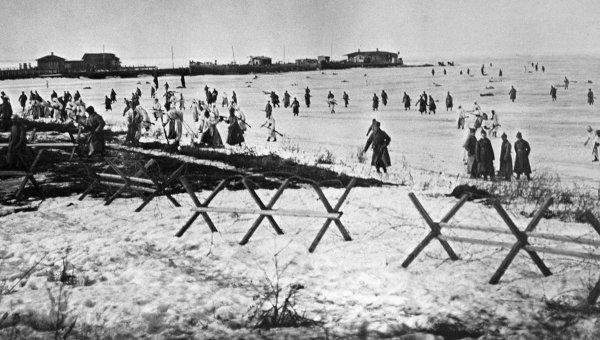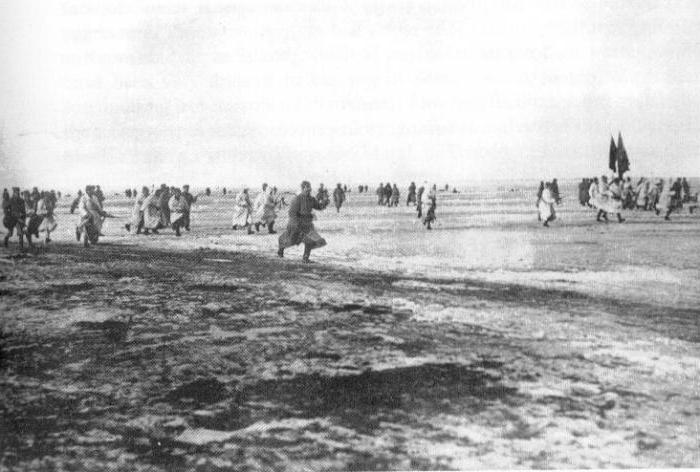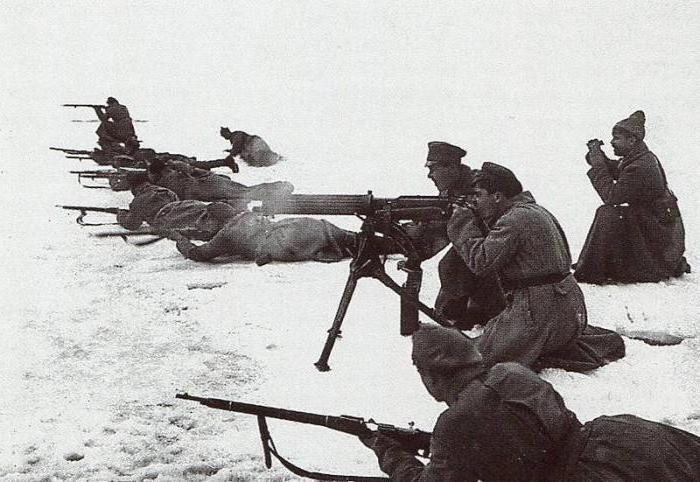In February Smolensk, Dokuchaev, an aide to the commander of the Western Front, sought out MN Tukhachevsky. They called from Moscow. Mikhail Nikolaevich was urgently called by the chief of the General Staff. He was found, after a long search, leaving the local orphanage, which the military commander helped to the best of his ability.
Revolt in the stronghold of the revolution
The cause of the call was the unrest in one of the strongholds of the October Revolution of 1917, a fortified city on the island of Kotlin, Kronstadt. By that time, completely different people were serving there. Over the course of three years, more than 40 thousand sailors of the Baltic Fleet went to the fronts of the civil war. These were the people most devoted to the "cause of the revolution." Many died. Of the most significant figures can be called Anatoly Zheleznyakov. Since 1918, the fleet began to be staffed on a voluntary basis. Most of the crew members were peasants. The village had already lost faith in the slogans that drew the villagers to the side of the Bolsheviks. The country was in a difficult situation. “Demanding bread, you give nothing in return,” - said the peasants, and were right. Replenished parts of the Ballot and even more unreliable people. These were the so-called "Zhorzhiks" from Petrograd, members of various semi-criminal groups. Discipline fell, cases of desertion became more frequent. The grounds for dissatisfaction were: interruptions in food, fuel, uniforms. All this facilitated the agitation of the Socialist Revolutionaries and agents of foreign powers. Under the cover of an American Red Cross worker, the former commander of the battleship Sevastopol Wilken arrived in Kronstadt. He arranged the delivery of equipment and food to the fortress from Finland. It was this dreadnought, along with the Peter and Paul and Andrew the First-Called, that became the stronghold of the rebellion.

The beginning of the Kronstadt rebellion
Closer to the spring of 1921, V.P. was appointed head of the political department of the naval base. Gromov, an active participant in the October events of 1917. But it was too late. Moreover, he did not feel support from the fleet commander F.F. Raskolnikov, more occupied with the unfolding polemic between V. I. Lenin and L. D. Trotsky, in which he spoke on the side of the latter. The situation was complicated by the introduction of a curfew in Petrograd on February 25. Two days later, the delegation returned from the city, consisting of part of the sailors of the two battleships. On the twenty-eighth day, the Kronstadters adopted a resolution. She was transferred to all members of the garrison and ships. This day of 1921 can be considered the beginning of the uprising in Kronstadt.
Uprising in Kronstadt: slogan, rally
The day before, the chief of the Fleet Political Department, Battis, assured that the discontent was caused by interruptions in the supply of food and the refusal to grant leave. Demands, meanwhile, were mostly political. The re-election of the Soviets, the elimination of commissars and political departments, the freedom of activity of the socialist parties, the abolition of detachments. The influence of peasant replenishment was expressed in points of freedom of trade and the abolition of food surplus. The uprising of the sailors of Kronstadt took place under the slogan: "All power to the Soviets, not parties!" All attempts to prove that political demands were inspired by the Social Revolutionaries and agents of the imperialist powers were unsuccessful. The rally on Anchor Square was not in favor of the Bolsheviks. The uprising in Kronstadt took place in March 1921.
Expectation
The suppression of the uprising of sailors and workers in Kronstadt was necessary not only for domestic political reasons. The rebels, if they had succeeded, could open a passage to Kotlin with squadrons of hostile states. And it was the sea gate to Petrograd. The “Headquarters of Defense” was led by former Major General A. N. Kozlovsky and Captain E. V. Solovyanov who served in the imperial army. Three battleships with twelve-inch guns, a Narva mine sweeper, a Lovat minesweeper, artillery, rifle and engineering units of the garrison obeyed them. It was an impressive force: almost 29 thousand people, 134 heavy and 62 light guns, 24 anti-aircraft guns, and also 126 machine guns. The uprising of the sailors of Kronstadt in March 1921 was not supported only by the southern forts. It should be borne in mind that for two hundred years of history, no one could take the sea fortress. Perhaps the overconfidence of the rebels in Kronstadt failed. Initially, troops devoted to Soviet power were not enough in Petrograd. If desired, the Kronstadters could capture the bridgehead near Oranienbaum on March 1-2. But they waited, hoping to hold out until the ice was opened. Then the fortress would become truly impregnable.
Under siege
The uprising of the sailors in Kronstadt (1921) came as a surprise to the authorities of the capital, although they repeatedly reported on the dysfunctional situation in the city. On the first day, the leaders of the Kronstadt Council were arrested and a Provisional Revolutionary Committee headed by the Socialist Revolutionary Petrichenko was organized. Of the 2,680 communists, 900 withdrew from the RCP (B.). One hundred and fifty political workers left the city unhindered, but the arrests nevertheless took place. Hundreds of Bolsheviks ended up in prisons. Only then did reaction from Petrograd follow. Kozlovsky and the entire composition of the "Headquarters of Defense" were outlawed, and Petrograd and the entire province were transferred to a state of siege. The Baltic Fleet was headed by I.K. Kozhanov, more loyal to power. On the sixth of March, shelling of the island with heavy guns began. But the uprising in Kronstadt (1921) could be eliminated only by storm. There was a 10-kilometer march on ice under the fire of guns and machine guns.

Hasty assault
Who commanded the suppression of the uprising in Kronstadt? The 7th Army of the Petrograd Military District was hastily recreated in the capital. To command her, Mikhail Nikolayevich Tukhachevsky was called from Smolensk , who was to suppress the uprising in Kronstadt in 1921. To strengthen, he asked the 27th Division, which was well known in the battles of the Civil War. But she had not arrived yet, and the troops at the disposal of the commander were almost not operational. Nevertheless, the order had to be carried out, that is, to suppress the uprising of sailors in Kronstadt as soon as possible. He arrived on the 5th, and on the night of March 7-8, an attack began. There was fog, then a blizzard rose. It was impossible to use aviation and adjust the shooting. And what could field tools do against powerful, concrete fortifications? The North and South groups of forces came under the command of E.S. Kazan and A.I. Sedyakin. Although the cadets of military schools managed to break into one of the forts, and special units even penetrated the city, the morale of the soldiers was very low. Some of them went over to the side of the rebels. The first assault ended in failure. It is significant that part of the soldiers of the 7th Army, as it turned out, sympathized with the uprising of sailors in Kronstadt.

Communists to strengthen
The anti-Bolshevik uprising in Kronstadt took place after the victory over Wrangel in the Crimea. The Baltic countries and Finland signed peace treaties with the country of the Soviets. The war was considered won. Therefore, it was such a surprise. But the success of the rebels could completely change the balance of power. Because Vladimir Ilyich Lenin and considered it a greater danger than "Kolchak, Denikin and Yudenich together." It was necessary at all costs to put an end to the rebellion, and before opening the ice cover of the Baltic. The leadership of the suppression of rebellion took over the Central Committee of the RCP (B.). The division devoted to Mikhail Nikolaevich Tukhachevsky arrived. In addition, more than 300 delegates of the X Party Congress held in Moscow arrived in Petrograd. A group of students from the Academy of the General Staff arrived . Among them were Voroshilov, Dybenko, Fabricius. The troops have strengthened more than 2 thousand proven Communists. Tukhachevsky scheduled a decisive assault on March 14. The term corrected the thaw. The ice still held on, but the roads were spread, which made it difficult to transport ammunition. The attack was moved to the 16th. Soviet troops on the Petrograd coast by that time reached 45 thousand people. At their disposal were 153 guns, 433 machine guns and 3 armored trains. The advancing parts were provided with uniforms, camouflage robes, scissors for cutting barbed wire. For transportation of ice ammunition, machine guns and the wounded, sledges and sledges of the most diverse design were delivered from all over the district.

The fall of the fortress
On the morning of March 16, 1921, artillery bombardment began. Bombed the fortress and aircraft. From Kronstadt they responded by shelling the shores of the Gulf of Finland and Oranienbaum. On the ice on the night of March 17, soldiers of the 7th Army set foot on ice. It was difficult to walk on loose ice, and rebel searchlights illuminated the darkness. It was necessary to fall and cuddle to the ice. Nevertheless, the attacking units were found only at 5 o’clock in the morning, when they were already almost in the “dead zone”, where the shells did not reach. But in the city there were enough machine guns. The many-meter wormwoods formed after the shells burst had to be crossed. It was especially difficult on the approach to fort No. 6, where a landmine exploded. But the Red Army still captured the so-called Petrograd Gate and stormed into Kronstadt. The fierce battle lasted a whole day. The forces of the advancing and defending were running out, as were the ammunition. By 5 o’clock in the afternoon the Red Guards were pressed to the edge of the ice. The outcome of the case was decided by the 27th Cavalry Regiment and the time-coming detachments of the St. Petersburg Communist asset. On the morning of October 18, 1921 there was a final suppression of the uprising in Kronstadt. The time while the fighting was on the coast, took advantage of many organizers of the uprising. Almost all members of the Provisional Revolutionary Committee fled across the ice to Finland. In total, nearly 8 thousand rebels managed to escape.

Repression
The first issue of the newspaper Krasny Kronshtadt appeared in less than a day. A journalist who in the 30s also did not escape repression, Mikhail Koltsov glorified the winners and promised grief to "traitors and traitors." During the assault nearly 2 thousand Red Army soldiers died. The rebels during the suppression of the uprising in Kronstadt lost over 1 thousand people. In addition, 2,100 people were sentenced to death, not counting those shot without any verdict. In Sestroretsk and Oranienbaum, many civilians died from bullets and shells. Over 6 thousand people were sentenced to prison. Many of those who did not participate in the leadership of the conspiracy were amnestied for the 5th anniversary of the October Revolution. There could have been more victims, but the Mines detachment did not support the uprising in Kronstadt (1921). If the ice around the forts was filled with mines, everything would have turned out differently. The workers of the Steamship Factory and some other enterprises also remained loyal to the Petrograd Soviet.
Kronstadt: the results of the uprising of the sailors in March 1921
Despite the defeat, the rebels achieved some of their demands. The central committee of the party drew conclusions from the bloody riot in the stronghold of the revolution. Lenin called this tragedy the flip side of the plight of the country, primarily the peasants. This can be called one of the most important results of the uprising in Kronstadt (1921). The need was realized for a stronger unity of workers and peasants. To do this, it was necessary to improve the situation of the wealthy strata of the population of the villages. The middle peasantry suffered the most notable losses from the surplus-surplus. Soon she was replaced by a tax deductible. A sharp reversal has begun from military communism to a new economic policy. It implied some freedom of trade. V. I. Lenin himself called this one of the most important lessons of Kronstadt. The "dictatorship of the proletariat" has ended, a new era has come.
We can talk about the cruelty of the era of "war communism" and many who enforced this policy. But it cannot be denied that the rebellion in the naval fortress would have been used not only to change the political course in Russia. Squadrons of many countries were ready to go to sea at the first news of the success of the rebellion. After the surrender of Kronstadt, Petrograd would become defenseless. The heroism of the Red Army during the assault is also undeniable. There was no shelter on the ice. Protecting the heads, the soldiers set themselves machine-gun boxes and skids. If powerful spotlights were used as they should, the Gulf of Finland would become the grave of thousands of Red Army soldiers. From the memoirs, it is known how Jan Fabrizius behaved during the attack . Before the start of the decisive throw, everyone saw a man walking forward in a black Caucasian cloak. With a Mauser, defenseless in front of hundreds of powerful guns, he, by his own example, raised infantry chains that were lying on ice in a decisive attack. Around the same time, the 19-year-old secretary of the Ivanovo-Voznesensky Provincial Committee of the Komsomol Feigin died. The opposite can be said of the rebels. Not everyone was sure that their cause was right. No more than a quarter of sailors and soldiers joined the rebellion. The garrisons of the southern forts supported the advancing 7th army with fire. All the naval units of Petrograd and the crews of the ships that wintered on the Neva remained faithful to Soviet power. The leadership of the uprising acted hesitantly, waiting for help after the disappearance of the ice. The composition of the "provisional revolutionary committee" was heterogeneous in composition. Eser Petrichenko, who was once a Petliurist, led, and included, a former gendarme officer, a major landlord, and the Mensheviks. These people were not able to make any intelligible decisions.

The experience of the underground work of many communists arrested on the island played a role. In conclusion, they managed to release their handwritten newspaper, and it denied allegations of the collapse of the Bolsheviks, which filled the newspaper, issued on behalf of the Kronstadt "revolutionary committee". During the first assault, V.P. Gromov, who commanded special battalions, managed to get into the city in turmoil and agreed with the underground on further actions. The Kronstadt garrison was isolated and did not receive support in other military units. And this despite the fact that their leaders did not oppose the Soviet regime. They wanted to use the form of the Soviets to overthrow the government. Then, perhaps, the Soviets themselves would have been liquidated. The indecision of the authorities of Petrograd in the early days was caused not only by confusion. Insurgencies against power were not uncommon. Tambov province, Western Siberia, the North Caucasus - these are just some of the regions where peasants with weapons in their hands met food detachments. But to feed the city, condemning the peasants to starvation, still failed. The largest ration in the capital was 800 grams of bread. The detachments blocked the roads and caught speculators, but trade from under the floor still flourished in the city. Rallies and demonstrations of workers took place in the city until March 1921. Then there was no blood and arrests, but discontent grew. And in the Petrograd Soviet, there was a struggle to control the fleet already infected with the rebel spirit. Trotsky and Zinoviev could not share powers.
The Kronstadt uprising of the sailors in March 1921 was the last and most powerful argument in favor of revising the policy of “war communism”. Already on March 14, the surplus appraisal was canceled. Instead of 70% of the grain, only 30% in the form of a tax in kind was taken from the peasants. Private enterprise, market relations, foreign capital in the Soviet economy - all this was a forced, largely improvisational measure. It was March of the first year of the second decade of the 20th century that became the time when the transition to a new economic policy was proclaimed. This has become one of the most successful economic reforms in the history of the country. And the sailors of the main sea fortress of the country played an important role in this.